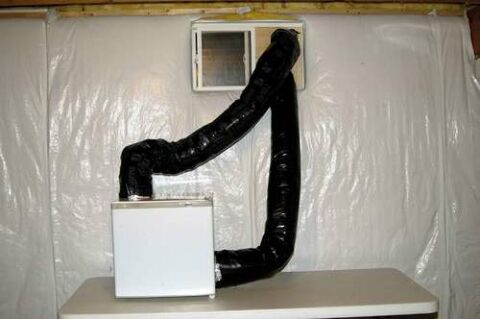Photo: nodyeliab @ instructables.com
A while back, we brought you the super-efficient .1 kWh/day fridge. It is quite an impressive machine. But, what if we said there is something even better? What if we said it is not only fairly cheap, but doable to your existing upright fridge? Thats right, it just keeps getting better and better.
Of course, there is a small catch. There is always a catch. If there wasn’t everyone would be doing it, right? Well, in this case, the outdoor temperature needs to be below 40 degrees F. It needs to be that cold out because the fridge uses outside air to cool itself down. The only thing that powers the fridge is two (possibly one depending on design) small computer fans to blow cold air into the fridge.
For a fair amount of people, this means you can cool your refrigerator for next to nothing for a decent part of the year. Add this to the fact that a refrigerator is a fairly large energy hog (1-2 kWh per day on average) and you have some pretty solid savings. Also, since your fridge won’t have to run the motor/compressor for months at a time, it should also last a fair amount longer.
So, check out the Build an ultra efficient fridge instructable and let us know what you think.


{ 5 comments }
The idea sounds great. Just make sure you do the math based on where you live first. The 0.1 KWH/day fridge will use 36.5 KWH a year. If you live somewhere such that 50% of the year is 40F or below then the other half of the year you would use 1 KWH/day for 182.5 KWH. If you like in Alaska, then this would be perfect for you. Now if you combine the two ideas together then you qualify as the ultimate eco renovator.
Soli Deo Gloria
– Chris
why not just set the fridge outside in a covered area when the weather cools off or maybe just relocate it to a basement? granted it will still use electricity but it will regulate its temprature much better.
for a true grid free fridge why not the pot in pot evaporative fridge
http://www.wikihow.com/Make-a-Pot-in-a-Pot-Refrigerator
The Pot in Pot design only works where relative humidity is very low. It will not work at all in Michigan 90% of the time.
There is another drawback – it is a complete waste of time, unless you solely use solar-water or wood-burning heat in the winter:
When the temperature outside is below 40 degrees, you are invariably using electrical energy to heat your home – whether it is direct electric heat, a heat-pump or a natural gas or propane-fueled forced-air furnace.
ALL of the waste energy from the inefficiencies of the refrigerator is returned to the home directly in the form of heat.
Therefore, any energy you think you’re saving by implementing this design in the winter is directly offset by the additional energy you consume to heat the home without this little ‘heater’ running. Just something to think about.
On the other hand, a ducting system to route the heated condenser-coil air outside in the summer is something to think about… Stop fighting the air conditioner, vent the generated heat directly outside.
To make it even more efficient, route a fresh-air intake from outside through a long, subterranean duct to pre-cool it before it gets to the condenser coil. This would balance the air pressures and eliminate the drawing-in of hot outside air to replace the ventilated, hot condenser-coil air due to the pressure drop inside the home caused by the fan.
If you want to get really smart, vent the hot air upwards and out to create a convection current and do away with the fans altogether!
Cheers,
-7
“the outdoor temperature needs to be below 40 degrees F. ”
=> 4.4C … hmm that makes it useless for me… it almost never gets that cold here, lucky to be below 10C even on ‘cold’ nights (50F)
Comments on this entry are closed.